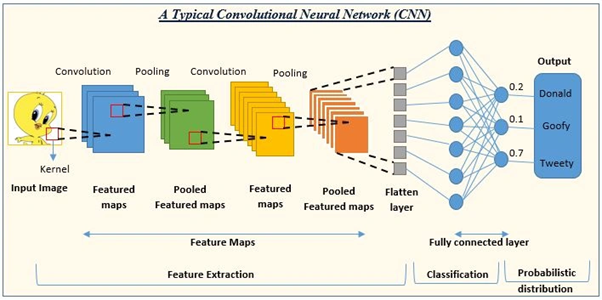Introduction
Convolutional Neural Networks (CNNs) have revolutionized the field of computer vision and image processing, becoming the de facto standard for tasks such as image classification, object detection, and facial recognition. By mimicking the way human visual perception works, CNNs can automatically learn to identify and extract features from images, making them a powerful tool in artificial intelligence (AI) and deep learning applications. This article delves into the architecture, functioning, advantages, challenges, and applications of CNNs.
What is a Convolutional Neural Network?
A Convolutional Neural Network is a specialized type of neural network designed to process data with a grid-like topology, such as images. CNNs are particularly effective at capturing spatial hierarchies in images through their layered architecture, which consists of multiple types of layers that transform the input data into meaningful representations.

Key Components of CNN Architecture
1. Input Layer: The input layer accepts raw pixel values from an image, typically represented as a three-dimensional tensor (height, width, depth). For instance, a color image with dimensions 100×100 pixels would have a shape of
-
-
-
- 100×100×3
- 100×100×3 (where 3 represents the RGB color channels).
-
-
2. Convolutional Layers: These layers are the core building blocks of CNNs. They apply convolution operations using filters (also known as kernels) that slide over the input image to detect features such as edges, textures, and shapes.
-
-
-
- Each filter produces a feature map that highlights specific patterns in the input data. The convolution operation involves computing the dot product between the filter and a local region of the input image.
-
-
3. Activation Function: After convolution, an activation function is applied to introduce non-linearity into the model. The Rectified Linear Unit (ReLU) is commonly used due to its effectiveness in accelerating convergence during training.
4. Pooling Layers: Pooling layers reduce the spatial dimensions of feature maps while retaining essential information. This downsampling process helps decrease computational load and mitigate overfitting.
-
-
-
- Common pooling techniques include Max Pooling (selecting the maximum value from a region) and Average Pooling (calculating the average value).
-
-
5. Fully Connected Layers: Towards the end of the network, fully connected layers are used to combine features learned from previous layers and make final predictions. Each neuron in these layers is connected to every neuron in the preceding layer.
6. Output Layer: The output layer generates predictions based on the learned features. For classification tasks, this layer typically employs a softmax activation function to produce probabilities for each class.
How CNNs Work
The operation of CNNs can be summarized in several key steps:
1. Convolution Operation: Filters slide over the input image to produce feature maps that capture various aspects of the image.
2. Activation: Non-linear activation functions like ReLU are applied to introduce complexity into the model.
3. Pooling: Spatial dimensions are reduced through pooling layers, which help retain important features while simplifying computations.
4. Hierarchical Feature Learning: As data passes through multiple layers, CNNs learn increasingly complex features—from simple edges in early layers to intricate shapes and objects in deeper layers.
5. Classification: The final fully connected layer processes these features to classify or predict outcomes based on learned patterns.
Advantages of Convolutional Neural Networks
1. Automatic Feature Extraction: Unlike traditional machine learning methods that require manual feature engineering, CNNs automatically learn relevant features from raw data.
2. Translation Invariance: CNNs can recognize objects regardless of their position in an image due to their hierarchical structure and pooling operations.
3. Reduced Computational Complexity: By using shared weights in convolutional layers, CNNs significantly reduce the number of parameters compared to fully connected networks.
4. Scalability: CNN architectures can be scaled up with additional layers and filters to improve performance on complex tasks.
Challenges and Limitations
Despite their advantages, CNNs face several challenges:
1. Data Requirements: Training CNNs requires large labeled datasets to achieve high accuracy; insufficient data can lead to overfitting.
2. Computational Resources: Training deep CNNs can be computationally intensive and may require specialized hardware such as GPUs.
3. Interpretability: Understanding how CNNs make decisions can be challenging due to their complex architectures, leading to concerns about transparency in critical applications like healthcare or autonomous vehicles.
Applications of Convolutional Neural Networks
CNNs have found applications across various domains:
1. Image Classification: Used extensively in identifying objects within images for applications ranging from social media tagging to medical imaging diagnostics.
2. Object Detection: Techniques like YOLO (You Only Look Once) utilize CNNs for real-time object detection in videos and images.
3. Facial Recognition: Employed in security systems for identifying individuals based on facial features.
4. Autonomous Vehicles: Used for recognizing road signs, pedestrians, and other vehicles in real-time for navigation purposes.
5. Medical Imaging Analysis: Applied in diagnosing diseases by analyzing X-rays, MRIs, and CT scans with high accuracy.
Conclusion
Convolutional Neural Networks have transformed the landscape of computer vision and artificial intelligence by enabling machines to learn from visual data effectively. Their ability to automatically extract features and recognize patterns has led to significant advancements across numerous fields.
As technology continues to evolve, ongoing research into improving CNN architectures—such as exploring new types of pooling methods or integrating attention mechanisms—will further enhance their capabilities and applications. Understanding how CNNs operate will be crucial for leveraging their potential responsibly and effectively across various industries in an increasingly digital world.
Spread the Word
